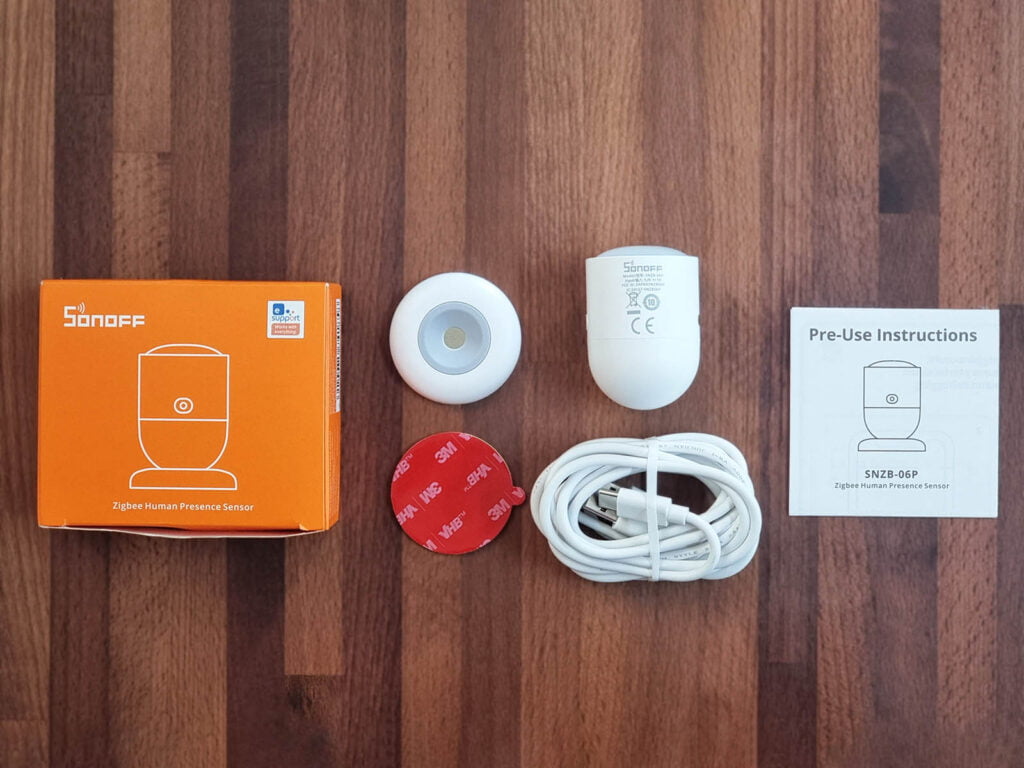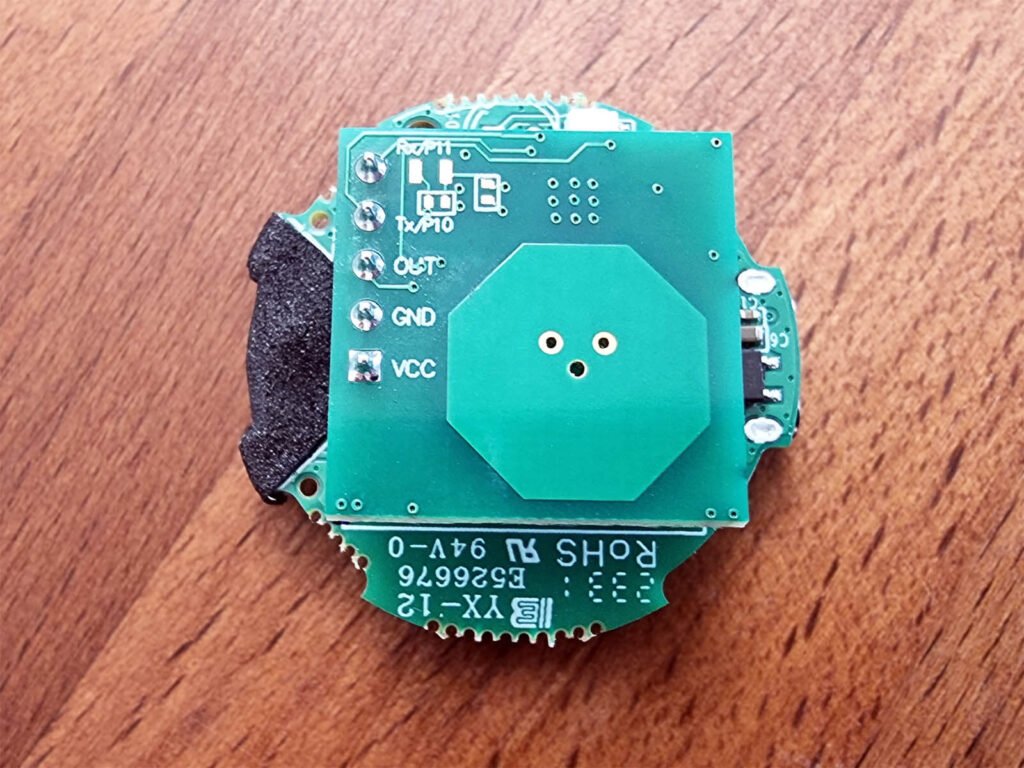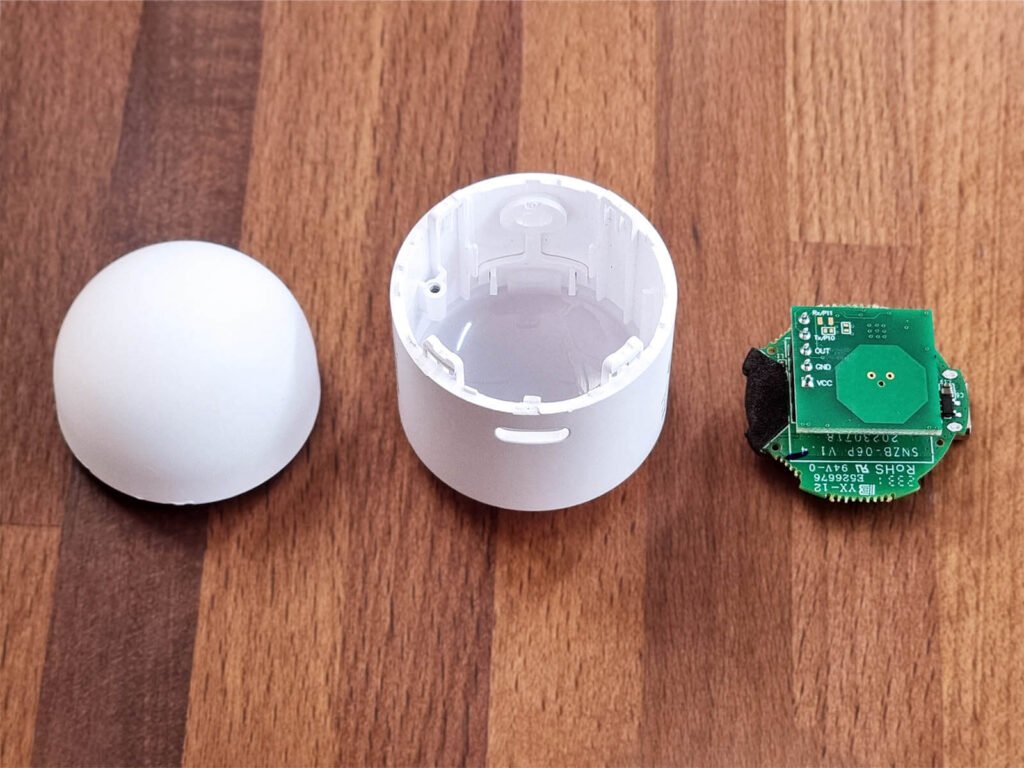
I’ve been experimenting with presence sensors for some time now, ever since the release of the Aqara FP1. You can check out my article of the Best and Worst Presence Sensors for Home Assistant for a TLDR list. If I had to pick a favorite:
In this article, I’m tearing down and testing the Sonoff SNZB-06P Presence Sensor, a very affordable (~$15) mmWave radar sensor available on AliExpress and Amazon. You can also get it on their Official Webstore.
Technical Specification SNZB-06P
- Brand: Sonoff
- Model: SNZB-06P
- Connectivity: Zigbee 3.0
- Input: USB-C, 5V1A
- Detection Distance: Max. 4m
- Detection Angle: 100°
- Dimensions: 44.2×44.2x59mm
- Operating Temperature: -10°C to +60°C
- Operating Humidity: 0-90% RH
- Home Assistant Support: ZHA, Zigbee2MQTT
Teardown

The Sonoff SNZB-06P Presence Sensor came in company branded box, along with a user manual, a mounting magnet and sticker and a pretty long USB-C powering cable. The device is properly packaged and cushioned, preventing shipping damage.

I slowly moved the device near the mounting magnet, making it snap in place immediately. The magnet feels very strong, definitely good enough to hold it in place. There is a small rubber ring on the bottom which will prevent the sensor from moving around if pulled from the powering cable.
The sensor is shaped like a capsule, with a plastic lens installed on the front. This is not a Fresnel lens like those usually found in PIR sensors, this is simply a matted pane improving the visual appearance of the sensor. mmWave radar does not benefit from Fresnel lenses, so there is no need for one.

Opening up the top was a prying operation using the prying tool from my Kaiweets set. I did not expect this thing to be so tightly assembled, and I slightly damaged the top dome from pulling so hard.
The first thing you notice is the USB-C port installed on one side, and the pairing button on the opposite one. This button doubles down as a status indicator, blinking red whenever the device is put in pairing mode.

Zooming into the main PCB, and you can see this device is powered by the EFR32MG22 [Datasheet] module developed by Silicon Labs from Austin, Texas. This is a low power Zigbee SoC Chip meant for battery powered End Nodes with a 76.8 MHz MHz ARM Cortex-M33 processor. This device is not an End Device, but will benefit from the power-saving features of the MG22.
Sonoff has been using these module a lot lately, also found in their SNZB-02D temperature sensor.

The Sonoff SNZB-06P Presence Sensor relies on the FR58 5.8GHz [Datasheet] mmWave radar sensor for detecting human presence, both moving and static. It’s worth noting that 5.8GHz has lower sensitivity and range compared to 24GHz radar sensors and is quite limited when used in metal containers (e.g. elevators. To learn more, check out the differences in this article.
In my experience, the choice between using 5.8GHz and 24GHz isn’t as critical as it might appear. What truly matters is how effectively the sensor’s operation is implemented in the device, particularly in terms of firmware. I’ve encountered instances where devices equipped with excellent 24GHz sensors performed poorly (e.g., Tuya PS-HPS), while those utilizing 5.8GHz worked perfectly well (e.g., Tuya ZY-M100). Remains to be seen.

Here’s an image of the Sonoff SNZB-06P Presence Sensor fully disassembled:

Home Assistant Integration
The Sonoff SNZB-06P Presence Sensor is fully supported in Zigbee2MQTT and ZHA . To put the device in pairing mode, press the button for about 7 seconds until the indicator LED starts blinking.
Zigbee2MQTT

Paired to Zigbee2MQTT, the presence sensor is identified correctly as model SNZB-06P by manufacturer SONOFF and automatically set as a network router. Heading over to the exposes tab, and this is what the device enables in Home Assistant through Zigbee2MQTT:

- Occupancy: Occupied / Clear
- Occupancy Timeout: Min. 15, Max. 65535 seconds
- Occupancy Sensitivity: Low / Medium / High
- Low sensitivity with a detection distance of 2.5m
- Medium sensitivity with a detection distance of 3.5m.
- High sensitivity with a detection distance of 4m.
- Illumination: Bright / Dim
- Linkquality: Signal quality in LQI
The Sonoff Presence Sensor also supports OTA updates in Zigbee2MQTT, and it’s highly recommended to update to firmware v1.0.5 and above if available. Versions bellow 1.0.5 have bugs and a minimum detection clearance of 30 seconds.
ZHA

Once added to ZHA, the Sonoff Presence Sensor is also correctly identified by it’s model name, SNZB-06P. A custom quirk is automatically applied, enabling the configuration cluster for the device.
For once, all entities are available in ZHA too, just like Zigbee2MQTT.
Testing and comparisson
To actually test the performance of the Sonoff SNZB-06P Presence Sensor, I decided to benchmark it against my favorite, the Apollo MSR-1. Some would argue the comparison isn’t really fair, considering the Sonoff is a budget device and the Apollo costs much more.
But what good is a presence sensor if it doesn’t perform as advertised? At the end of the day, you don’t want a device that occasionally works. You want a reliable presence sensor that always works.
I installed both devices on top of my PC case, overlooking my office.

I made sure everything works in Home Assistant, the Apollo being connected via ESPHome and the Sonoff integrated through Zigbee2MQTT. I set the sensitivity of the Sonoff to High and lowered the detection duration to 15 seconds. With similar settings on the MSR-1, I conducted several tests.
Test 1: Sitting still in office chair (1 meter)
In order to test for false negatives, I sat still in my office chair at a distance of about 1 meter. The moving target entity of the MSR-1 would fluctuate between clear and detected whenever I typed on my keyboard. Staying completely still gave me no false negatives on both sensors.
Test 2: Entering office from terrace (2.5 meters)
To test the response time, I entered from the room terrace at a distance of about a 2.5 meters. The Apollo MSR-1 picked up my movement immediately, closely followed by the Sonoff. My logs say the difference was 0.4 seconds. Winner: Apollo MSR-1.
Test 3: Entering office from door (5 meters)
Entering from 5 meters at the main door, the Apollo MSR-1 again detected my movement immediately. The Sonoff however, triggered at about 4 meters, which is the maximum detection distance when sensitivity is set to high. Winner: Apollo MSR-1.
Test 4: Sitting still at table (4 meters)
For the final test, I sat at a table in my office corner at a distance of about 4 meters. I pivoted both devices towards me and tried to be completely still. Surprisingly, there were no false negatives after 20 minutes and both devices kept their occupied state.

Summary
The Sonoff SNZB-06P Presence Sensor turned out to be a pretty solid device, all things considered. It performed as advertised, with no false negatives in my tests. It’s possible the device will trigger from ceiling fans, PC fans and pets, which is a thing almost all presence sensors need to deal with.
I would conclude that the Sonoff is a great choice for mass deployment, but only if you have small rooms. It will not be able to reliably detect presence at a distance larger than 4 meters, no matter how you position and setup the device.
I don’t consider this false advertising, since the official webstore does state the maximum distance is 4 meters (13 feet). Highly taking price into account (~$15), the Sonoff is an excellent choice for an mmWave radar presence sensor.
If you are looking for an extremely capable, tweakable multi-sensor with an mmWave radar, I can’t recommend the Apollo MSR-1 enough. You can get it on their Official Webstore (US) and OpenCircuit (EU) and read my review here. Some buying links for the Sonoff:

OFFICIAL WEBSTORE
Itead.cc
![]()
AliExpress | AliExpress | AliExpress![]()
United States | Canada | United Kingdom
Germany | Netherlands | Sweden
Spain | France | Italy
*If links fail to open, try disabling your AdBlocker.










Thanks for Test, great as always!
Did you do any testing how much Energy (W, kwh per day, nevermind) it consumes? Or maybe could you observe it for a couple of Days? 😬
I’m keen on Presence Sensors, but fear a little bit the Consumption (and thus costs) per Year, compared to a Battery (PIR) Sensor.
Energy consumption will typically range from 0.3 to 1W for mmWave radar sensors, which amounts to 7.2 to 20W every 24 hours.
Extended monthly, 216 to 600W. Extended yearly, 6.4KW to 7.2KW.
Even if you double this amount, it’s a ridiculously low total sum in my opinion.
Great Thanks! Well yeah, if you compare it with the yearly consumption of an Oven its almost nothing.
But its on par with a yearly Lights’ Consumption in a Room :-p
And with my local Energy Prices beeing 2-3€ yearly it wont be a big Deal, yet definitly an Increase.
Im still convinced that a Combination of PIR and Presence, the first toggeling the latter, while charging the Battery while beeing active, would be the perfect Mix to unite the advances of both Worlds.
Well, I might have been unlucky, but it did not work in my walk in closet at all, detecting presence randomly even on low setting. And no, there’s nothing moving there nor any airflows that would trigger movement.
Customer support suggested many different options which did not help and never agreed on a refund.
While having a lot of other sonoff devices that are working perfectly fine, I am very disappointed with this device and support overall.
Hello,
It’s very unlikely you received a faulty device. I would say next to impossible.
You need to look for the causes that’s triggering movement. Sometimes it can be things you are not expecting at all.
Did you update the firmware of the device?
Why would you say that? Sonoff is infamous for having awful quality control and worse customer support. Their zigbee temperature sensors are known for getting “stuck” or just refusing to stay connected, and their in-wall relays have horrible lag that can be up to several seconds long.
Sonoff is a Moes that markets itself like an Aqara.
Great review; I appreciated the teardown and the additional details. Thanks SHS!
I bought one of these last month and found it works perfectly for detecting presence in the bedroom closet, where the detection distance is 5-10 feet. I can confirm the SNZB-06P doesn’t work well for larger rooms. Tried it in the living room and it would keep thinking I wasn’t in the room, even though I was just watching TV. But that room is too large for the smaller range of this presence sensor. In smaller spaces (like a home office, bathroom, closet) I think it would be suitable. Thanks!
Thanks for the feedback.
Yes, as I stated it cannot work reliable in rooms longer than 4 meters.
For anything bellow that, it’s perfectly suitable.
Cheers.
This isn’t really a sufficient set of tests for a lot of real-world circumstances.
The biggest flaw with 5.8 GHz (which isn’t mmWave, by the way) is the wall penetration: if you have a floorplan that forces you to place this somewhere where it will see through a wall into a hallway, it will be worse than useless.
Furthermore, it’s not sensitive enough to detect presence if someone is asleep in the room. Even 60 GHz can fail there depending on the algorithms, but 5.8 has basically no way to be reliable in this scenario. Even just sitting for a few hours it will stop detecting at times if you’re close to the max distance (in my case, about 3.5 m).
I say all this having bought one, tried it in several rooms and orientations, and finding it useless and tossing it in a drawer. Oh well.
I got one of these today to detect bed occupancy.
With Z2M I am missing the occupancy entity and only have the motion (detected/clear).
I also find it gets locked on detected constantly. Pretty annoying product.
You need to update Z2M to the latest version if you haven’t already.
Than you need to update the firmware of the Sonoff to + 1.05.
I noticed that you said the 5.8 GHz is limited when used in metal containers such as elevators. I actually just bought one of those expandable container homes to set up as a small office in my yard and am planning to extend my zigbee network to cover it as well. Of course, being a glorified shipping container with windows and doors, it’s all metal construction may be an issue. So I’m curious what exactly you mean by “limited when used in metal containers”. Does this mean the range is reduced or am I going to have issues with false positives and negatives more often, or will I have some other issues?
This is all very subjective, but I do think you are going to encounter false negative triggers more than usual.
Since mmWave emits radio waves and waits for the them to travel back and trigger a response (known as the echo time), with 5.8GHz many will be lost in a metal container since it’s not powerful enough.
Your best bet is to just try it out.